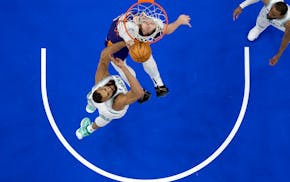New coach, new quarterback, even new turf on the practice field. But it was more than that, too.
"It feels different," said MarQueis Gray, whose changing role, from receiver to quarterback, is one of the Gophers' biggest changes from 2010. "It feels like we're ready."
Ready to work, he means, because new coach Jerry Kill and his staff emphasized how far away the Gophers are from being prepared for their Sept. 3 opener against Southern California. But on a warm, sunny day, the Gophers began a new era in their football history with a two-hour practice that mostly served as an indoctrination for all the newcomers.
"We're beginning one of the longest marathons these kids will mentally and physically have ever run," offensive coordinator Matt Limegrover said.
And the large number of new faces -- starting with the coach -- added an air of anticipation to the proceedings.
At one end of the field, Max Shor- tell, a 6-6 freshman from Kansas, took snaps with Gray and Tom Parish, providing a hint about his relative position in the derby to be Gray's backup. At one point, Shortell completed a long pass to Victor Keise, a Floridan whose Gophers receiving career so far amounts to only one catch but who could emerge as an answer to the team's depth problems at receiver.
"Victor went up and got the ball -- that's what we need, a lot of playmakers like that to go get the ball for us," Gray said. "We're still looking for that No. 2 guy behind Da'Jon [McKnight]. Not to say that Victor is that No. 2 guy, but with that catch, he opened up some eyes today."
So did Malcolm Moulton, a deep-threat wideout who transferred this summer from Fort Hays Community College in Kansas. The speedy sophomore made a couple of catches in traffic, and Gray expressed his optimism over Moulton's ability to adapt quickly to Big Ten football.
"Moulton's got the speed," Gray said. "Most people haven't seen him jump, but I'm pretty sure, once we get him a jump ball, he's going to go up and get it. He has nice hops."
Receiver was considered the Gophers' thinnest position, with McKnight the lone wideout with any experience. As if to emphasize the shortage there, McKnight took part only in conditioning drills, as he recovers from a knee injury in the spring that the senior said only stopped hurting him late last month. He's getting close to completely healed, McKnight said, but he'll probably avoid contact for an additional week or so to be safe.
Is the guy who has to throw passes to this receiving corps worried? Not at all, Gray said.
"Coach Kill and his staff did a great job going out and finding guys to help us in that area," he said, citing Moulton and Marcus Jones, a true freshman from North Carolina who was one of the biggest surprises of spring ball. "Guys have been standing up in our summer workout also."
Now it's up to one of the quarterbacks to stand up behind Gray. Having gone through similar competitions the past couple of seasons, Gray is looking forward to the spectacle. "It's good to see them make plays. It puts a little smile on their face, and lets you know they're getting confident," the junior QB said. "But we also have to eliminate the bad plays. I'm going to help them."
The spirit of cooperation is important, said defensive tackle Brandon Kirksey, who judged the Gophers' summer of conditioning a success. "We did all the physical stuff. It's about developing the mental [part] now," he said. "This is our bonding time. It's about building trust with your teammates."
A few teammates were missing: center Ryan Wynn and offensive lineman Jonathan Ragoo were missing for personal reasons, Kill said. Wynn, dealing with a death in the family, is expected back soon, but Ragoo's future is uncertain. Freshman running back Quentin Gardener cannot suit up until an eligibility issue with the NCAA clearinghouse is resolved. And offensive tackle Brooks Michel, who suffered a serious concussion during spring drills, will not play this season, Kill said.
But that still leaves plenty of newcomers for the coaching staff to evaluate and develop, which will be the emphasis for the first week or two of fall drills.
"We have to teach them some things, and then we'll throw them out there and see if they're ready to play as an underclassman," Kill said. "If they're not, we know we'll redshirt them. You're not going to get to practice at the pace and [accomplish] all the things we want to do here until we get people to learn."
NFL draft has been on tour for a decade and the next stop is Detroit, giving it a shot in spotlight

Souhan: Wolves fans made Game 1 special. Now bring on Game 2.

Will Wolves show best-in-the-NBA defensive form in Game 2?

Former Totino-Grace star set to follow father as first-round pick

